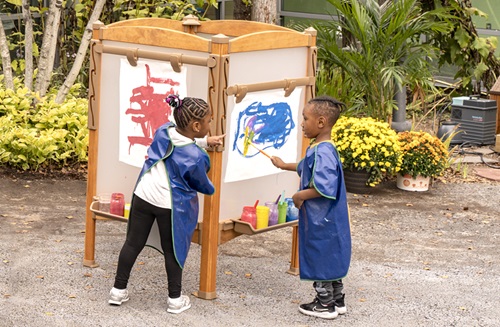Choosing What to Plant
| April 2012Preparing the Garden
Working with the Earth to create a garden, however small, is an experience that every child should have. To be able to tend and care for the Earth in this way engenders attitudes of stewardship. The rewards of this caring go far beyond the harvest of vegetables, flowers, fruit, and fun. It really is true that children are much more likely to eat things they've picked from their own garden. And this realization that the food we eat comes from the Earth—as a result of the labors of humankind—nurtures their sense of security and the wholeness of life and allows them to feel gratitude for the gifts the Earth so generously gives.
Encourage the development of these sensitivities by taking the time and making the effort to garden with your children. Gardening is probably the single most important thing that you can do to make children more environmentally aware.
When constructing the garden, remember that you can start small and get bigger as you go along. Your garden needs to have beds in which you plant your seeds and pathways between the beds. You can make your beds just wide enough so that a child can reach to the middle from a path on either side. That way they don't need to walk right where the plants are growing. For container gardening, you can use almost anything from large, half-barrels to flower pots to window boxes to boards nailed together to make a frame. The important thing is that you have sunlight, enrich your soil, and don't overcrowd your plants.
Choosing What to Plant
If you are a teacher who does not work with your children through the summer, you will need to choose vegetable varieties that will sprout and mature quickly so that you can enjoy them with the children before school is out in June. You may also want to choose varieties that will be ready when you return in the fall, for example, pumpkins and popcorn. If you are teaching throughout the summer, you have the advantage of lots of time and, also, a built-in solution to the problem of garden care over the summer months. In fact, the garden can really become a focus of your summer program.
You will need:
- Vegetable seeds such as radish, lettuce, carrots, peas, pumpkins, popcorn, beans
- Flower seeds such as zinnia, marigold
- Herb seeds such as mint, chamomile, parsley, lavender, sage, thyme
- Hand trowels
- Watering can
- Optional—eggshell halves
What to do:
When looking for vegetable varieties that will mature quickly consider:
- Radish—the fastest growing vegetable, often ready to eat in three weeks or so. There are the round red and long white varieties. They are easy to grow and wonderful to harvest. Follow the package directions for sowing. Some children love to eat them, others find their spiciness a bit much. Try cutting them into slivers.
- Lettuce—try the leafy varieties as these mature more quickly than head lettuces. There are many different kinds and they do well when planted with radishes.
- Peas—these can be started early on as they like cool weather. They come in climbing and bush varieties so plan accordingly for whichever you choose.
If you will be around during the summer, you can choose to plant just about anything you like. If you will be gone from your garden until late summer or early fall, plant things that you can harvest then, and pray for rain. We used to plant flowers such as zinnias and marigolds, herbs such as mint, chamomile and parsley, and vegetables such as pumpkins, winter squash and popcorn. We mulched our garden heavily before our summer leave-taking to keep down weeds and keep in moisture. In the fall when school resumed, we weeded the garden and got it back into shape. The flowers kept producing blooms that graced our Season’s Garden, and we waited until the first frost to harvest our popcorn and until close to Halloween to bring in our pumpkins. One year our biggest pumpkin (and it was gigantic!) was a “volunteer” which sprouted in our compost pile.
When choosing what to plant, keep in mind the idea of companion planting. This means growing next to each other certain plant varieties that do well together by nourishing each other and/or by discouraging harmful insects. Marigolds are well known insect inhibitors and make a fragrant, colorful garden border. They also enliven your autumn Season’s Garden and make a sunny yellow natural dye (simmer the flower heads) for cloth or wool! Other plants that do well together are:
- Carrots with peas and lettuce
- Tomatoes with parsley
- Parsnips or potatoes with peas and beans
- Corn with pumpkins
Once you’ve decided what to plant, follow the care and planting instructions on the seed packets, and seek additional guidance and advice from gardening books and experienced gardeners (maybe parents).
Remember that many seeds can be started on a sunny window sill in-doors several weeks before you plant them outside. This works especially well for tiny seeds such as herbs and lettuce. Plant them in saved eggshell halves. When you’re ready to transplant, just gently squeeze the shell to crush it and set the whole thing, plant, shell and all, into the garden. The shell actually provides some nutrients, too.
All vegetables enjoy the presence of aromatic herbs such as lavender, sage, and thyme which are a delightful addition to your garden. The herbs can be used to brew snack time teas and hung in bunches to fry for cooking and making sachets.
Material from Earthways, by Carol Petrash, (pages 150-155), ISBN 978-087659-156-7, reprinted with permission from Gryphon House, Inc., P. O. Box 10 Lewisville, NC 27023.









